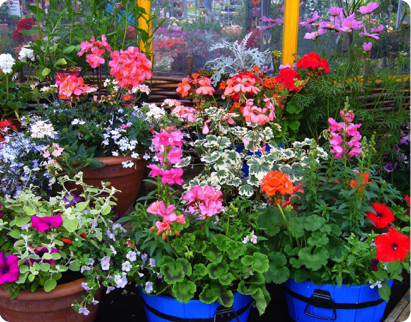
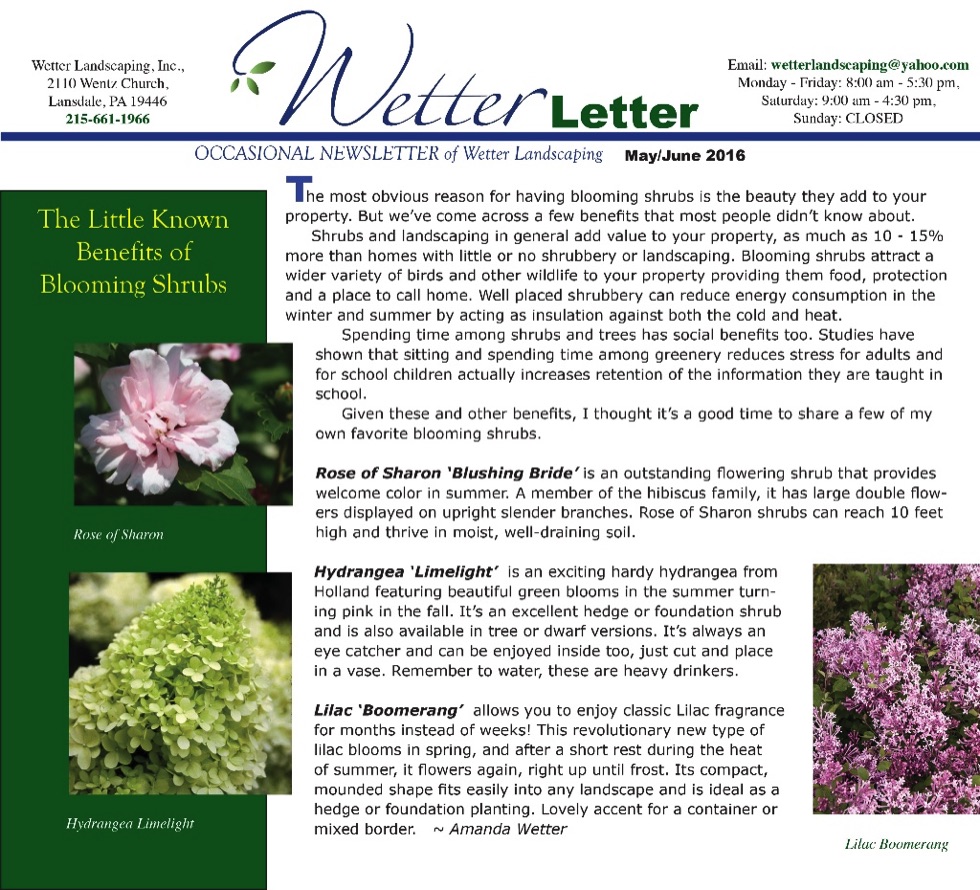
Wetter Letter Newsletter Archives
Scroll down to see recent newsletters by date published
May / June Newsletter, Little Known Benefits of Blooming Shrubs; published May 18, 2016
April Newsletter; How to be Successful in Prepping Your Lawn for Spring, published April 12, 2016

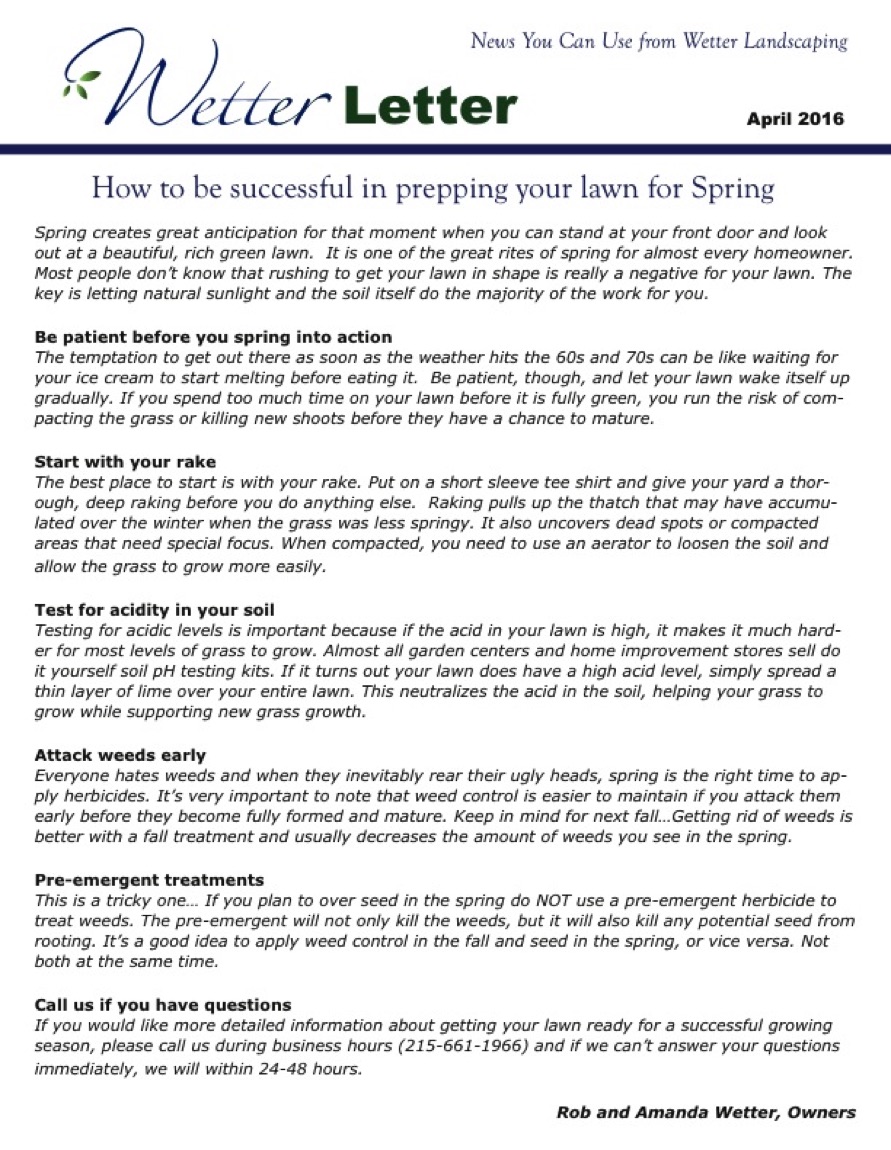
Spring Newsletter; New website and newsletter introduction, published March 12, 2016
About Summer Lawns
Summer can cause quite a bit of stress to your lawn. Heat and summer droughts can cause damage and take away a lot of the enjoyment that a green and lush lawn provides. By understanding and respecting the seasonal changes of turf grasses, you can take steps to care gently for your lawn as temperatures rise.
• Cool-season grasses (such as fescue, bluegrass, and rye)
grow best when temperatures are in the 60s F.
• Warm-season grasses (including Zoysia, St. Augustine,
Centipede, and Bermuda) like temperatures in the 70s.
Once temperatures get into the 80s and above, lawns will begin to
show their vulnerability, with cool-season grasses having the hardest
time. Growth will slow, color may fade, and lawns will show signs of
wear and tear as they are less able to recover from stress and traffic.
Some cool-season lawns will even go dormant in the summer, looking
brown and brittle until early fall.
Here are some valuable tips to minimize damage from heat and
summer conditions.
Water Wisely
Don’t Over Fertilize
If your lawn is looking straggly in midsummer, resist the urge to
fertilize. In fact, it’s best to stop fertilizing about 30 days before
your area’s summer temperatures arrive. Applying extra fertilizer in
the heat of summer can burn your lawn and create a flush of tender
growth that will struggle in the hot summer weather. Never fertilize
dormant lawns – wait until they green up in the fall.
Organic fertilizers are naturally slow-release, and they are much less
likely to burn your lawn (or pollute the environment) than chemical
fertilizers.
TIP: Try Jonathon Green Organic Fertilizer, available at your local Agway.
High-Traffic Areas
By summer, many lawns begin to show signs of wear, especially in a few popular pathways. Consider installing stepping stones to minimize damage to your grass, and try to minimize traffic on dormant, brittle lawns. If you’re getting plenty of rainfall and your lawn is actively growing, you can apply a bit of fertilizer to these areas to help the blades recover faster.
Control Weeds
Summer is the season to get those growing weeds removed before they bloom and disperse seed for next year. Targeted postemergent herbicides are designed to kill broadleaf weeds without harming turf grass, but they must be applied when temperatures will be below 85° F for a few days. Keep in mind that during the heat of summer, ANY product can be damaging to already-stressed lawn grasses, so use sparingly or hand-pull weeds instead.
TIP: Use weed control products when temperatures are under 85 degrees F.
Insects and Diseases
• Dormant or drought-stressed summer lawns can be more susceptible to insect infestations, such as chinch bugs, cutworms, armyworms, sod webworms, fire ants, fleas, and mosquitoes. Minor infestations often take care of themselves, but severe problems may require attention.
• Summer is also the time for fungal diseases, such as powdery mildew and brown patch. Apply fungicide if needed, and avoid watering in the evening to keep nighttime moisture at a minimum.
• Grubs will begin hatching in your lawn over the summer. If grubs typically cause problems in your lawn, you can begin applying grub control around midsummer.
TIP: Use insecticides only if you have severe lawn damage.
Summer
Event
Reminder
If you're having a wedding, graduation or just any big party on your property during June, don't forget to contact us as soon as possible if your regular mowing schedule needs to be modified. We are happy to accommodate you but it sure helps to know as far in advance as possible. We appreciate your consideration.
$50 Wawa Gift Card Drawing
We'd love a review
Visit our
Newsletter Archives
Click here to visit our Archives page where you'll find lawn and garden information you might have missed.
Wetter Landscaping, Inc., 2110 Wentz Church, Lansdale, PA 19446 • Email: wetterlandscaping@gmail.com • Phone: 215-661-1966
Business Hours: Monday - Friday: 8:00 am - 5:30 pm, Saturday: 9:00 am - 4:30 pm, Sunday: CLOSED
PA Licensed Contractor #059812
Keeping your Summer lawn healthy and looking good

Letter
OCCASIONAL NEWSLETTER of Wetter Landscaping
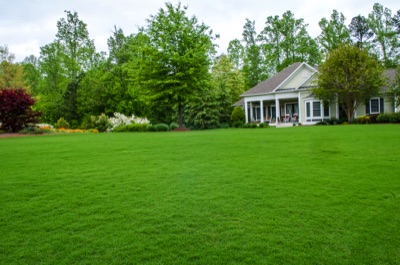
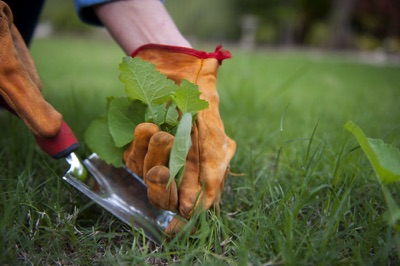
TIP: Small tuna cans make a good temporary water gauge.
Mowing Tips
• Raise your mower blade in the summer. Taller grass is more drought-tolerant, grows deeper roots, and helps shade the earth to prevent weed seeds from germinating. Cool-season grasses should be mowed at 3”- 4” during the summer, or as high as your blade will go, while warm-season grasses should be mowed at 2”- 3”.
• Mulching grass clippings helps keep moisture levels steady.
• Mow regularly, to prevent cutting more than 1/3 of the grass blade at a time. This keeps your grass healthier and prevents the clippings from smothering the grass.
.

• Keep mower blades sharp. Make sure your mower is cutting your grass, not tearing it, to minimize stress during hot temperatures.
TIP: Remember, mowing higher means mowing more often
Wetter Landscaping, Inc.,
2110 Wentz Church,
Lansdale, PA 19446
Email: wetterlandscaping@gmail.com • Phone: 215-661-1966
Business Hours:
Monday - Friday:
8:00 am - 5:30 pm,
Saturday: 9:00 am - 4:30 pm, Sunday: CLOSED
PA Licensed Contractor #059812
Content: Today's Homeowner.com. Julie Day.
We’d love to have some new testimonials for our website. Please consider writing a brief review and emailing to wetterlandscaping@yahoo.com and we’ll automatically place your name in our new $50 Wawa Gift Card Giveaway. Please email us by June 30 as the drawing will take place on July 1. Many thanks.
Summer Newsletter, Keeping your Summer Lawn healthy and looking good; published June, 2016
There are great reasons to consider an automatic sprinkler system for your property. Not only will it help keep your lawn and landscaping beautiful and healthy looking but it is the easiest and most efficient method of getting your lawn the water it needs. When correctly installed, it is also a great way to conserve water as well.
Everyone worries about giving their lawn either too much or too little water. And when your lawn develops that dreaded brown color, it's often too late to recover for the rest of the season.
There are two ways to go when it comes to an irrigation system. Either a professionally installed or a do it-your-self automatic irrigation system will work perfectly if competent planning is exercised. Anyone who has an automated system will tell you it's one of the best investments they've made to their property. It is an easy and cost effective method to enhance your home and property, increase its value and, in the long run, save yourself a lot of precious time and money.
There are several critical factors to consider. It's not just a buy a system and magically your lawn is happy and beautiful. The design of your irrigation system will ultimately determine its performance, durability and longevity. Before you actually begin installing a system, whether it's a DIY or professionally installed, a system design should be created.
Wetter Landscaping can provide a professional installation or help you
plan your own do-it-your-self strategy. We work closely with the best
vendors and manufacturers and can create a design plan that will be
cusomized for your specific lay of the land and requirements.
Not only can we provide the basic equipment for an automatic
irrigation system, but we also offer rain shut-off and moisture sensing
devices that will help save even more water and reduce costs over the
lifetime of your system. Give us a call for a no-obligation consultation
to learn how we can improve your lawn and landscaping and save you
time, water and expense.
In summary, here's the benefits of considering an automated water
sprinkler system:
• your system will do all the watering for you saving you hours of time each week
• an automated system will utilize less water than watering by hand
• your water bills will be reduced and your plants will live longer
Summer
Event
Reminder
If you're having a wedding, graduation or just any big party on your property during the summer, don't forget to contact us as soon as possible if your regular mowing schedule needs to be modified. We are happy to accommodate you but it sure helps to know as far in advance as possible. We appreciate your consideration.
Summer Hardscaping Special
Save 10% on Patios, Retaining Walls and Walkways.
Please call to see if you qualify for other Hardscaping Projects
you may need.
Offer expires 8/31/16,
maximum $300 discount
Visit our
Newsletter Archives
Click here to visit our Archives page where you'll find lawn and garden information you might have missed.
Consider the benefits of an
automated sprinkler system
Wetter Landscaping, Inc.,
2110 Wentz Church,
Lansdale, PA 19446
Email: wetterlandscaping@gmail.com • Phone: 215-661-1966
Business Hours:
Monday - Friday:
8:00 am - 5:30 pm,
Saturday: 9:00 am - 4:30 pm, Sunday: CLOSED
PA Licensed Contractor #059812
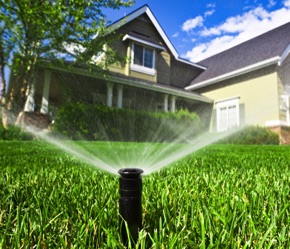
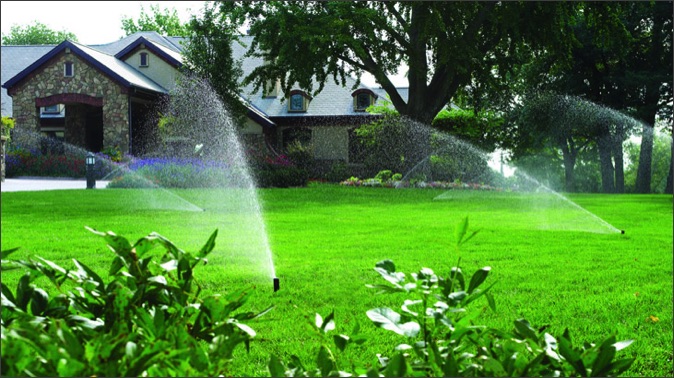
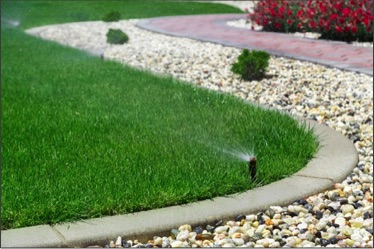
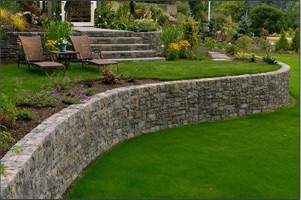
Congratulations to Ann Becker of Lansdale.
She is the lucky winner of our $50 WAWA Gift Card for our July Testimonial Drawing,

Summer Newsletter, Benefits of an Automated Sprinkler System, published July, 2016
It's true. Get over it. Summer is done. Even though we'll have some beautiful warm days, once those school bells ring, the summer spirit is history. But with that departure comes the opportunity for renewal. And to accomplish projects on your property than you just never got to last spring. We all know that fall is a great time to plant and to tackle tasks that will help next spring be better than ever.
This month Wetter Landscaping wants to share some great tips for fall planting and next month we'll tell you why you should consider aerating your lawn and tips on how to do it.
No matter what style of gardening you practice or what zone you live in, fall plantings gives you the opportunity to expand your garden options. It's a great time to plant perennials, bulbs, trees and shrubs. Before you plant though, make sure to allow adequate time for the roots to get established before the real cold weather hits. Roots grow in the fall but slower than warmer seasons, even when soil temperature gets as low as 40 degrees.
When the weather starts dipping and fall is upon you, plant the species that are easily established such as deciduous shrubs and Maple, Ash, Thornless Honey Locust, Crabapple, Sycamore and Horse Chestnut trees. Better to wait till spring to plant trees that are slower to establish like Oak, Birch and Willow. If you're going to mulch don't load up around the trunk.
Recently, there have been conflicting methods for planting trees but most experts agree not to dig your hole deeper than the depth of the root ball or container but three or four times as wide. Ask us for the best methods based on where you live and the type of soil you have.
Fall has specific benefits for planting. The cooler air makes it easier on both plants and gardeners. The soil is still warm allowing roots to grow until the ground freezes. Fall has a greater number of good days for planting than in the spring. Spring rain and other unpredictable weather can make working the soil a lot more difficult. And of course there's more free time as opposed to the frantic days of spring. And let's not forget the great deals offered on trees, shrubs and perennials in the fall when nursery inventories need to be cleared out.
If you love the uplifting sight of tulips and daffodils in the spring, fall is definitely the time to go out and bury a bunch of bulbs. Plant more than you think you need to account for losing some to squirrels. All spring-blooming bulbs need a period of cold dormancy to bloom. Plant bulbs in fall to ensure a beautiful spring display. If deer or other critters frequent your yard, plant bulbs
Summer Hardscaping Special Extended
Save 10% on Patios, Retaining Walls and Walkways.
Please call to see if you qualify for other Hardscaping Projects
you may need.
Offer expires 9/30/16,
maximum $300 discount
Visit our
Newsletter Archives
Click here to visit our Archives page where you'll find lawn and garden information you might have missed.
Wetter Landscaping, Inc., 2110 Wentz Church, Lansdale, PA 19446 • Email: wetterlandscaping@gmail.com • Phone: 215-661-1966
Business Hours: Monday - Friday: 8:00 am - 5:30 pm, Saturday: 9:00 am - 4:30 pm, Sunday: CLOSED
PA Licensed Contractor #059812
Lots of options for fall projects, it's the best time for planting
OCCASIONAL NEWSLETTER of Wetter Landscaping
October 2016 Newsletter - Scroll Down to See More
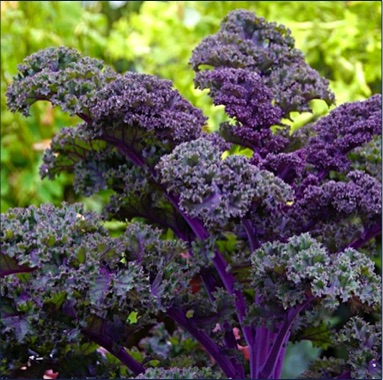
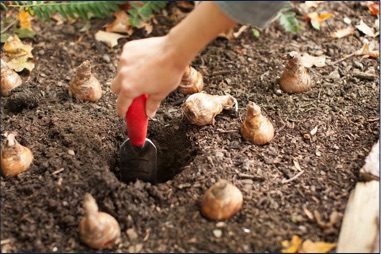
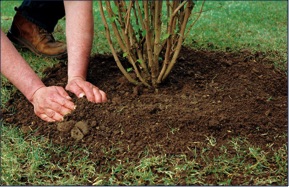
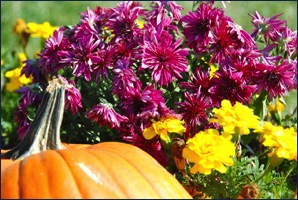
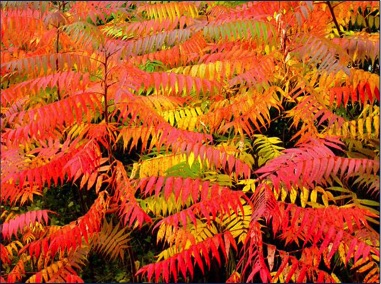
they don't like to nibble, such as Daffodil, Crown Imperial, Grape Hyacinth, Siberian Squill, Allium, Fritillaria, English Bluebell, Dog's-tooth Violet, Glory-of-the-snow, Winter Aconite, or Snowdrop.
Of course fall is the best time to patch up those bare spots on your lawn. The combination of warm soil and cool air are good for getting new grass to grow. It's also a good time to manually remove weeds and filling them over with grass seed. Planting seeds for perennials and biennials for your garden makes good sense because the winter does a good job in winterizing the seeds so they germinate in the spring. Put the seeds directly into the ground where you want them to grow.
Fall is the best time to establish new turf and do most lawn chores. Around our parts, cool-season grasses such as bluegrass, fescue, and ryegrass should be fertilized in early September and again in late October or early November to give a boost for earlier spring green-up.
There are lots of fall tasks that can enhance your lawn, gardens and overall landscaping. Get yourself organized by picking the realistic projects for your available time. Mark your calendars now to avoid looking back in November and wishing you would have done it when you had the chance.

2110 Wentz Church Road
Lansdale, PA 19446
Email: wetterlandscaping@gmail.com • Phone: 215-661-1966
Business Hours:
Monday - Friday:
8:00 am - 5:30 pm,
Saturday: 9:00 am - 4:30 pm, Sunday: CLOSED
PA Licensed Contractor #059812
Aerating and seeding in the fall season is one of the most important aspects of year-round maintenance for your lawn and property. Although they can be done separately, it is typically best to consider both aeration and seeding services together, as your lawn is most viable for seed growth right after aeration is completed
Aeration Benefits
Aeration is a pretty big deal in the lawn-care world, and you probably have seen the after-effects, even if you did not realize that it was called aeration. Aeration is the process through which air is circulated through, mixed with or dissolved in a liquid or a substance. The technical definition is a bit complicated, so to simplify with respect to lawn care: aeration is the process through which soil is either pounded down with spikes, or removed as core samples. In both cases the effect is the same, i.e., pockets appear where air can enter the soil more easily. Experts recommend aerating twice a year, once in spring (March-May), and once in fall (August-November). If you missed the first season, then don't stress! Just make sure to get the fall aeration done to ensure a healthy lawn throughout the winter.
The benefits of aeration compared to the time and money you may invest to accomplish the task are overwhelming. Aeration offers some of the most easily recognizable, and quickest results of any lawn maintenance operation. and below is a list of just seven of the benefits of aeration:
1. Water and Fertilizer can be used more efficiently by your lawn
2. Thatch will be minimized
3. Grass roots can grow deeper and healthier
4. Soil compaction is reduced
5. Improved lawn health
6. Improved lawn appearance
7. Ability of lawn to withstand more activity
Year-Long Beauty
Items 2 and 7 on the list, cannot be overstated enough. Thatch is a layer of dead, mostly plant tissue that protects lawns by regulating temperature. Too much thatch however, can limit soil oxygenation and watering effectiveness! Giving your lawn a good once-over with a rake can prevent some of the negative side-effects of thatch, but to truly make sure your lawn is great, aeration is necessary. Number 7 is especially important for people who like to gather outside. Anyone who has ever had a bonfire, or a party outdoors, knows that the lawn looks beaten down the next day. Aeration prevents soil from compacting under heavy strain, and also allows your grass to return more quickly to its natural state, minimizing the chance for damage.
Aeration and Grass Growth
“So what does this mean for grass growth?” You might ask. The answer is two-fold. When aeration is performed alone, the existing grass gains deeper roots, but this can lead to spotty grass due to over-competition for nutrients. To truly capitalize on your newly aerated lawn, over-seeding must be performed, and now is the perfect time to do it! Over-seeding is the process in which more grass seed than needed is laid down to increase the chance of seed germination. The whole process takes about 8-10 weeks, hence why we recommend doing it now, and almost always leads to a healthier and denser lawn. Putting down lots of grass seed also ensures that your existing grass does not grow its roots too long, which is also why we recommend performing over-seeding as soon as possible after aeration.
We hope that this summary has been helpful. If you have any questions, or would like to schedule an aeration and seeding, or any other lawn care service, call us during business hours. Wetter's team of trained professionals will ensure that your lawn is the health, happy, and beautiful.
Visit our
Newsletter Archives
Click here to visit our Archives page where you'll find lawn and garden information you might have missed.
When and Why: The Benefits of Fall Aeration and Seeding

2110 Wentz Church Road
Lansdale, PA 19446
Email: wetterlandscaping@gmail.com • Phone: 215-661-1966
Business Hours:
Monday - Friday:
8:00 am - 5:30 pm,
Saturday: 9:00 am - 4:30 pm, Sunday: CLOSED
PA Licensed Contractor #059812

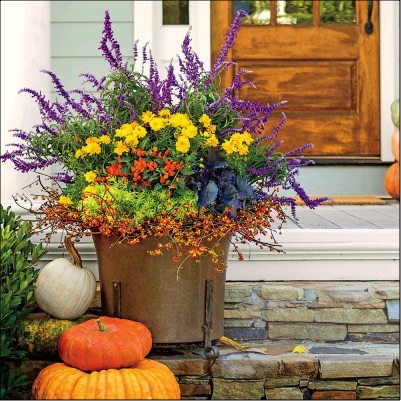
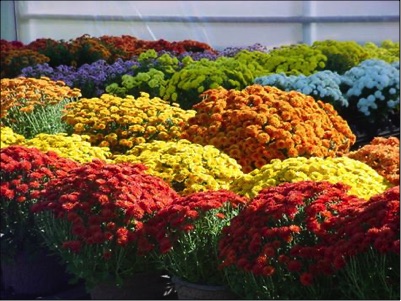

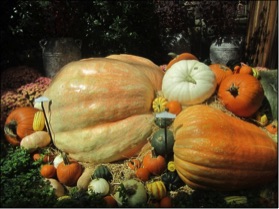
Hurry to get on our fall leaf cleanup schedule
AND for help with your fall planting projects.
We have mums, cabbage, pansies and violas.
Call Wetter Landscaping Today!!
215-661-1966
October 2016
There are two obvious choices when it comes to doing your fall leaf clean-up: do it yourself or hire a professional. Wetter Landscaping provides this service and we take great pains to make sure we do it for you as efficiently as possible to keep costs down. We'll provide a free estimate based on your property and nature of the clean-up.
Many people don't realize that a fall leaf cleanup isn't necessarily a once-a-season task. It depends on the length of the fall season and the degree of neat and tidy you want on your property. Adjoining property owners may not have a similar philosophy as yours and their leaves can end up on your property adding to the job.
The good news is that do-it-yourself leaf removal doesn't have to be a blister-inducing, exhausting project. With the right tools, leaves can be gone before Sunday afternoon kick-off time.
Doing it yourself? Tips for making it easier
Come this time of year, drop your lawnmower settings down as low as it'll go without scalping the turf. Short grass gives leaves less to get caught on as they drift around the neighborhood. It also means the mower will vaporize any leaves that have already fallen.
You can also purchase a mulching mower—the kind without a bag that pulverizes clippings and drops them back into the turf to feed it. If you're going to use a leaf blower stay away from the wimpy types that can barely blow out a candle. The typical plug-in version usually isn't powerful enough to do the job efficiently. Invest a few extra bucks and get one that can handle the job properly.
Use a large tarp to move large leaf piles to either the curb for pick-up or the woods. Even better are leaf haulers which usually have sidewalls to keep the leaves corralled. They are not expensive and can save a lot of aggravation.
If you must pack your leaves into brown paper bags for municipal curb pickup, check out the Leaf Chute ($9 at Lowe's or Home Depot). It's a low-tech, three-sided plastic tube that props open the empty bag and has a wide mouth for easy loading. Once the bag is full enough to stand on its own, remove the chute and pack in as many more leaves as you can stamp down.
We all think about just letting nature take its course when it comes to fall leaf cleanup. Before choosing to just let things take care of themselves, remember that excess leaves on the lawn blocks sunlight and reduces water evaporation, which can cause fungus, mold and disease. If leaves get too thick, they can cause stress to a lawn and require re-seeding or even worse for your lawn, Wet, decomposing leaves can also be a breeding ground for mosquitoes so weigh the risks before choosing to cross a fall leaf cleanup off your list.
Cleaning up your fall leaves can be a relatively simple project when you choose to work smarter, not harder.
Visit our
Newsletter Archives
Click here to visit our Archives page where you'll find lawn and garden information you might have missed.
Leaf Cleanup and How to Winterize Your Irrigation System

2110 Wentz Church Road
Lansdale, PA 19446
Email: wetterlandscaping@gmail.com • Phone: 215-661-1966
Business Hours:
Monday - Friday:
8:00 am - 5:30 pm,
Saturday: 9:00 am - 4:30 pm, Sunday: CLOSED
PA Licensed Contractor #059812
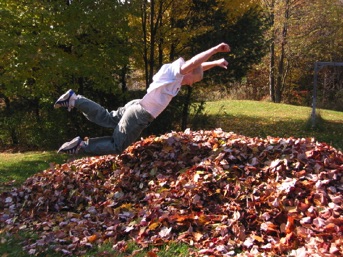


Winterizing your irrigation system
Without proper preparation your sprinkler system might be damaged by freezing temperatures. Here are some tips from Rain Bird on how to prepare your irrigation system for winter conditions.
1. Insulate your assets: Shut off the water supply to the irrigation system. The main shut off valve for your irrigation system needs to be protected against freezing. Make sure it is wrapped with insulation (foam insulation tape and a plastic bag) to protect it from harsh winter temperatures and prevent it from freezing. If you do not have a main shut off valve, you might consider installing one as a preventative investment. Also, any above ground piping needs to be insulated. Self-sticking foam-insulating tape or foam insulating tubes commonly found at home supply stores are fine.
2. Stay in control: If you have an automatic system then you will need to "shut down" the controller (timer). Most controllers have a "rain-mode" which simply shuts off the signals to the valves. The controller continues to keep time, the programming information isn't lost (start times, valve run times, etc.) and the clock continues to run throughout the winter. The only change is that the valves will not activate. If your controller is responsible for activating a pump, as a precaution you should remove the wires that are connected to the MV (Master Valve) and common terminals. This will prevent the possibility of the pump being accidentally activated which could cause damage from overheating. An alternative to using the rain mode is simply to shut off the power to the controller. If you do, you'll need to reprogram the time and potentially all your other settings as well, in the spring.
3. Drain the pipes: Now you need to remove the water from the pipes and sprinklers so that it won't freeze/expand and break the pipe. There are several ways to drain your pipes: a manual drain valve, an automatic drain valve or the compressed air blow-out method. However, since there could be potential safety risks we recommend contacting Wetter Landscaping as we offer sprinkler winterization services this time of year for many of our customers.
4. Protect valves and backflow preventers: Insulate backflow preventers and valves if they are above ground. You can also use insulation tape for this. Be sure not to block the air vents and drain outlets on backflow preventers.
Reprinted from RainBird
Winter Reminder
We provide winter plowing services for commercial properties and Home Owner's Associations. Sorry but we are unable to provide snow plowing for private residences.
November / December 2016
Diminish your winter lawn damage
Although we've had a lot less snow than usual, winter temperatures, wind and moisture will still take its toll on your lawn. When we look at our lawn in general, we don't see the thousands of individual grass plants. Some may be damaged and some may not. That's because there are a variety of ways a lawn can be damaged.
Shade definitely hinders grass growth because the sun is needed for photosynthesis. In the winter months, shade covers different areas
Visit our
Newsletter Archives
Click here to visit our Archives page where you'll find lawn and garden information you might have missed.

2110 Wentz Church Road
Lansdale, PA 19446
Email: wetterlandscaping@gmail.com • Phone: 215-661-1966
Business Hours:
Monday - Friday:
8:00 am - 5:30 pm,
Saturday: 9:00 am - 4:30 pm, Sunday: CLOSED
PA Licensed Contractor #059812
Referral Reminder
Don't forget about our Wetter Referral Program. For every new contracted customer you refer, you'll receive a free lawn cut. Just contact our office to make your referral or find out more information.
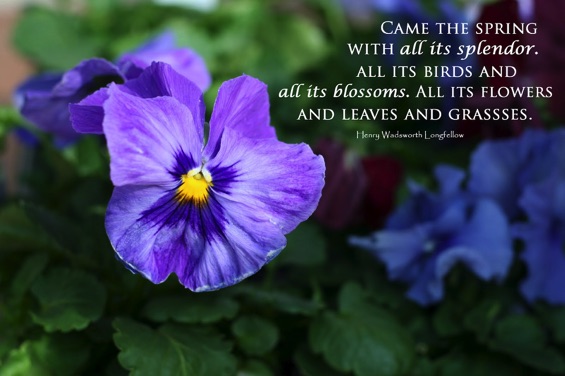
It's never too soon to prepare for Spring!
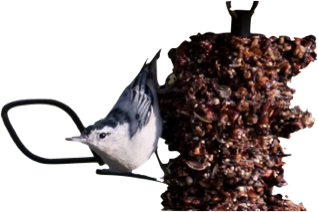
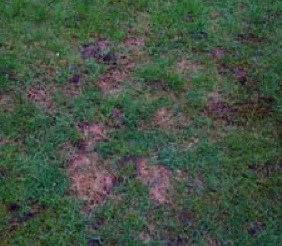
of your lawn than in the summer. Soil compaction damages root growth all year long, not just in winter. Poor drainage areas will also damage oir even kill plants especially in winter months. Other factors including soil structure, air circulation and fungus diseases also can damage or even kill your grass plants.
Proactive solutions you or Wetter Landscaping can provide
While there is virtually no way to avoid these conditions in winter, you can mitigate some of their impacts in early spring with a couple important strategies. Wetter Landscaping offers these services or you can do them yourselves depending on how much time and effort you can invest.
• Aerate to help dry out the soil and promote fertilizer and water intake
• Thatch lightly to comb out dead grasses
• Seed and mulch to
◦ Provide new and improved grass varieties
◦ Increase the number of plants per unit of area
◦ Replace grass plants that may have died over the winter
Seed generally will not thrive where there is too much shade or where the soil has become too compacted. To make matters more difficult, it is very hard to tell when your soil has become compacted and that's why a professional is sometimes needed to diagnose your lawn problems.
There are other remedies that can be employed and we would be glad to come out an do an assessement of what mnight be done to minimize your winter lawn damage.
Winning the war on weeds means
pre emergent weed applications
There is no debate that an early start will make the war on weeds less brutal. Our pre emergent weed applications will get you the best results and we have varying treatments for different types of lawns.
Contrary to popular belief, pre-emergent weed killers don't destroy weeds and their seeds. They simply stop them from growing. Some seeds are known to last fifty years, so if the herbicide isn't applied each year, the weed will grow.
The big question for pre-emergent weed killers is when to apply them. Pre-emergent herbicides only work if they are applied to your lawn before the weed's growth period. But if applied too early, weather will dilute the herbicide and the weed will grow unencumbered.
According to garden experts from many regions of the U.S., the two dates to remember are March 15 and September 15. Those are the two dates of the year around which pre-emergent fertilizers should be applied so that they activate before seasonal weeds make an appearance.
Birdfeeding tips from the Northeast
Pennsylvania Audobon Society
Birds will find most of their food in the wild. They do not really need us to feed them, but it is fun and educational. To keep them from eating you out of house and home, set a limit on the amount of feed you will give the birds each week. The birds will adjust to the amount you give them.
Small birds do not feel safe crossing large open spaces because of hawks. Place your feeders near shrubs and trees, but not too close, because cats and other predators can hide there. Some seed on the ground will attract ground feeders like juncos, mourning doves, and various sparrows.
It is good to have more than one feeder so the birds will not fight over the food.
Keep your feeders clean and dry. If the seed becomes wet, remove it, wash the feeder and dry it before adding new seed. Moldy seed can make birds sick or even kill them in some circumstances.
Black oil and striped sunflower seeds attract many birds – including cardinals, woodpeckers, goldfinches, purple finches, chickadees, titmice, and nuthatches – and there is little waste. Nyger seed is best for attracting goldfinches as well as redpolls and pine siskins during the winter.
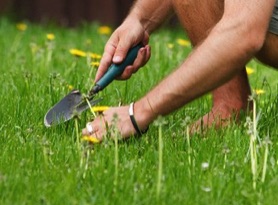
Visit our
Newsletter Archives
Click here to visit our Archives page where you'll find lawn and garden information you might have missed.
Spring 2017
2110 Wentz Church Road
Lansdale, PA 19446
Email: wetterlandscaping@gmail.com • Phone: 215-661-1966
Business Hours:
Monday - Friday:
8:00 am - 5:30 pm,
Saturday: 9:00 am - 4:30 pm, Sunday: CLOSED
PA Licensed Contractor #059812
Referral Reminder
Don't forget about our Wetter Referral Program. For every new contracted customer you refer, you'll receive a free lawn cut. Just contact our office to make your referral or find out more information.
Mulch is the icing on the cake to any new landscape design, controlling weeds and offering a multitude of benefits to your garden flowers and plants. But before you put down mulch in your yard, there are some tasks that need to be completed. Below are 10 steps to prepare your landscape and flower beds for mulch.
1. Kill weeds in your landscape
Before adding mulch and embarking on your garden landscaping ideas, it's important to eliminate all unwanted plants and weed growth. Pulling up and removing unwanted plants is a simple and efficient natural weed killer. Another method for how to kill weeds is to spray them with an herbicide one to two weeks prior to mulching. This will allow the weeds to completely die. (Dead weeds are easier to pull up.)
2. Trim trees and bushes in your yard
It is best to trim nearby trees and bushes before mulching because of the debris they create.
3. Clean out your garden beds
Use a rake to remove dead leaves, weeds and trimmings. An adjustable rake is generally best for this task.
4. Cultivate your landscaping beds
After your beds have been cleaned, cultivate any compacted soil or mulch. A rototiller or hand cultivator will do the job. Cultivating will allow moisture and air to pass through the soil more easily.
5. Edge landscape beds before adding garden mulch
Creating a clean edge really enhances your landscape and gives it a professional look. An edging shovel or power edger can be used to create your edge. Try using a garden hose as a guide to create flowing curves.
6. Before you mulch your landscape, rake the area smooth
Using a stiff rake, such as a mud rake, smooth out all the surfaces to be mulched. Otherwise, your mulched flower beds or mulched areas around trees will look lumpy.
7. Apply a pre-emergent to prevent weeds
Apply a pre-emergent, such as Preen, to prevent germination of weed seeds. A second application, after the mulch has been installed, can add protection from weed seeds that may germinate into the mulch.
8. It’s time to mulch your landscape and flower beds
Using your hands or a rake, apply new mulch over the existing cultivated mulch or soil. Most experts suggest a layer of mulch 2 inches (but no more than 3) thick. When mulching around trees and woody, stemmed plants, keep the mulch away from the base. When you're finished mulching, water to moisturize mulch and help it settle into place.
9. Mulch maintenance
Once a month or so, check your mulch for compaction. If compacted, use a garden claw, rake or cultivator to loosen (scratch) it. This will allow water and air to pass, which helps prevent the growth of fungus and restores its appearance.
10. Address fungus in garden mulch right away
If fungus is present, remove it and the surrounding mulch. Rake existing mulch to cover the area, and then water thoroughly. Fungus is a sure sign that your garden mulch is compacted and your beds have dehydrated. Cultivation and watering will be necessary.
Bed edging: Keep it simple
The simplest and most subtle borders that effectively separate your lawn from a garden are 4-in.deep strips of steel, aluminum or plastic. They all bend easily into smooth, graceful curves and stop the spread of grass roots. However, painted aluminum and steel offer the sleekest, most refined look because they almost disappear against the grass and garden bed. The plastic types have a prominent black bulge along the top edge. All work best on fairly even terrain; if you have a lot of dips and rises, it's easier to install a paver border.
Although aluminum and steel cost about the same, we like aluminum because it is much lighter. It weighs about 41 lbs. per 100 ft., while steel weighs about 225. With aluminum, you get a professional look without the heavy lifting.
Plan to set the border with the top edge about 1/2 in. above the soil level to maintain the lawn/garden separation and keep roots from crossing over the top. This makes the border almost invisible and allows you to mow right over the top. However, be aware that the thin top edge can hurt bare feet. After cutting it, make sure you round off any sharp edges with a file.
The key is to cut a clean vertical edge along the grass with a square spade. Then you can lay the border tightly against the edge when you stake and backfill it. There's no rule for shaping the edge. Simply follow the edges of your lawn, making smooth, gradual curves. To make smooth, sharp curves, bend the edging around a circular form.
Look Things Over and Make a Plan
By now you've probably taken a walk around your property and observed first hand any damage and impacts from the winter season. Take stock of the situation and plan your projects for the year. Check out the turf for dead spots that may need seeding, address areas where poor drainage has caused your grass to thin, and check for structural problems with any of your ornamentals.
The first steps to launching your spring offensive is make a good hit list of the things you'll want or need to do. Mulch, weed control products, pruning and equipment are good things to consider.
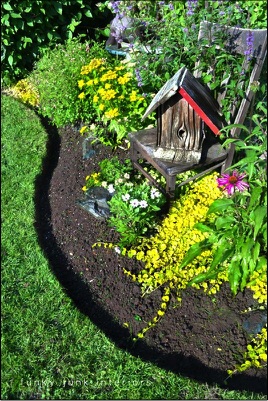
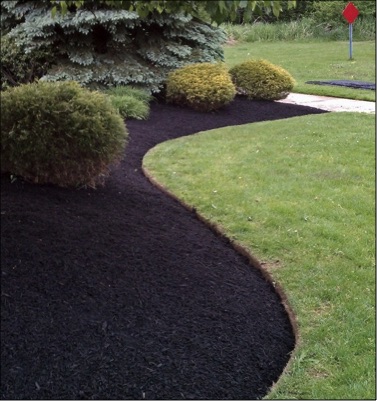
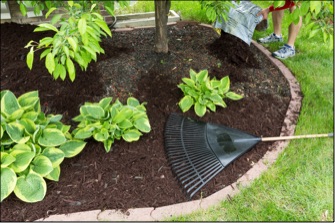
Tips to launch a beautiful
property appearance

Spring clean-up, bed edging and mulching
Buying Edging
Steel edging is the most common metal edging, although you might not find it at local nurseries. Look for it at larger garden centers or at landscape suppliers, which is where most pros get it. (Search “Landscape Equipment and Supplies” online or in your Yellow Pages.) Steel edging comes in 4-in. wide by 10-ft. long strips in a variety of colors. Keep in mind that it'll eventually rust, especially in a salt environment. It's heavy, floppy stuff and needs almost full support when you transport it.
Aluminum edging, besides being lighter and stiffer, won't rust and is also available in a wide variety of colors. Look for it through landscaping suppliers, although it might be difficult to find. You might have to order it. Be sure stakes are included with your purchase. You'll find black plastic edging at every garden center and home center, sometimes in both regular and heavy-duty thicknesses. Buy the thicker material. It better withstands those inevitable bumps and hard knocks that go with lawn mowing. Also, please call your local utilities or 811 to locate underground lines before you dig and install all edging.
Mulching helps your landscaping in a variety of ways
We Deliver Mulch
$36 per yard delivered (brown dyed)
$38 per yard delivered (black dyed)
Delivery within a
10 mile radius
of our shop.

2017

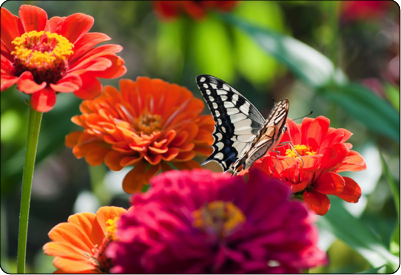
Visit our
Newsletter Archives
Click here to visit our Archives page where you'll find lawn and garden information you might have missed.
2110 Wentz Church Road
Lansdale, PA 19446
Email: wetterlandscaping@gmail.com • Phone: 215-661-1966
Business Hours:
Monday - Friday:
8:00 am - 5:30 pm,
Saturday: 9:00 am - 4:30 pm, Sunday: CLOSED
PA Licensed Contractor #059812
Referral Reminder
Don't forget about our Wetter Referral Program. For every new contracted customer you refer, you'll receive a free lawn cut. Just contact our office to make your referral or find out more information.

Watering and plant care tips for summer
We Deliver Mulch
$36 per yard delivered (brown dyed)
$38 per yard delivered (black dyed)
Delivery within a
10 mile radius
of our shop.

2017

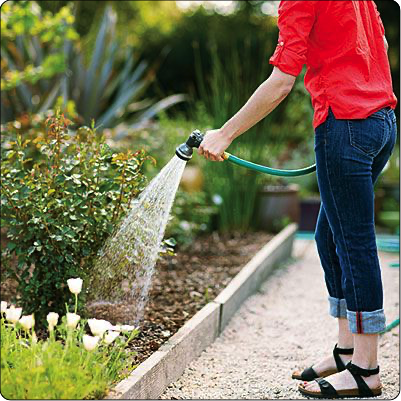
Plant Shading Trees and Plants on the West
During the summer, the sun remains high and in the sky a lot longer than it does in winter. No matter where you are, the sun is going to set in the west.That's why you should plant your garden on the west side of your home so the sun isn't beaming down on your garden at the hottest point during the day. Also, you could plant certain types of trees and vining plants to protect your more sensitive flowers from the summer heat. Try sunflowers, perennials and Asiatic lilies.
Choose Plants and Flowers That Like the Heat
One of the easiest ways to protect your garden through the summer heat is to add plants and flowers that thrive in the heat. Some examples of beautiful and colorful flowers that withstand a lot of heat include:
• Salvias, which tolerate extreme heat and extreme cold.
• Coreopsis flowers, which are bright yellow and need very little water to thrive.
• Coneflowers that come in a rainbow of colors and can grow up to three feet.
• Rudbeckia, also known as "black-eyed Susan" perennials, which are drought-resistant and grow 48 inches high. Plus, you can cut them and stick them in a vase inside the house; they last longer than most cut flowers. If you are growing a fruit and vegetable garden, tomatoes are surprisingly hearty against summer heat. Other vegetables like eggplant and black-eyed peas and certain fruits will also thrive in hot and humid weather.
Water Your Plants in the Early Morning
Finally, you want to be careful about how you water your plants. There are several things you may not know that will help keep your plants from drying out this summer. The first rule is to water your plants early in the morning. If you water your plants at night, chances are you'll get some of the leaves wet. Overnight, that water can turn into mildew and disease. Once the sun rises, the heat is going to burn off the water too fast for your plants to absorb it. In the morning, they will have a better chance of absorbing water. Second, just because it rains, it does not mean that your plants have had enough water.
You can measure by leaving a tuna can outside in the rain. One can equals an inch of rain. Your plants need a third of that every few days to thrive. If your soil gets too dry, it could become resistant to water and will need more water than usual.
Consider an irrigation system
to save time, water and expense
Everyone worries about giving their lawn either too much or too little water. And when your lawn develops that dreaded brown color, it's often too late to recover for the rest of the season.
There are two ways to go when it comes to an irrigation system. Either a professionally installed or a do it-your-self automatic irrigation system will work perfectly if competent planning is exercised. Anyone who has an automated system will tell you it's one of the best investments they've made to their property. It is an easy and cost effective method to enhance your home and property, increase its value and, in the long run, save yourself a lot of precious time and money.
There are several critical factors to consider. It's not just a buy a system and magically your lawn is happy and beautiful. The design of your irrigation system will ultimately determine its performance, durability and longevity. Before you actually begin installing a system, whether it's a DIY or professionally installed, a system design should be created. Wetter Landscaping can provide a professional installation or help you plan your own do-it-your-self strategy. We work closely with the best vendors and manufacturers and can create a design plan that will be
cusomized for your specific lay of the land and requirements.
Not only can we provide the basic equipment for an automatic irrigationsystem, but we also offer rain shut-off and moisture sensing devices that will help save even more water and reduce costs over the lifetime of your system. Give us a call for a no-obligation consultation
to learn how we can improve your lawn and landscaping and save you time, water and expense.
In summary, here's the benefits of considering an automated water sprinkler system:
• your system will do all the watering for you saving you hours of time each week
• an automated system will utilize less water than watering by hand
• your water bills will be reduced and your plants will live longer
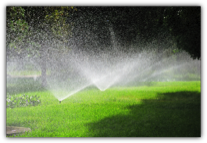
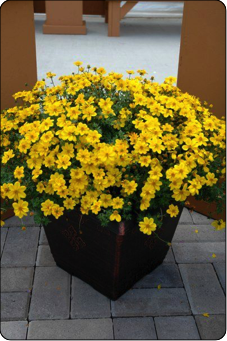

Nothing But Upsides to Fall Aeration and Seeding

2110 Wentz Church Road
Lansdale, PA 19446
Email: wetterlandscaping@gmail.com • Phone: 215-661-1966
Business Hours:
Monday - Friday:
8:00 am - 5:30 pm,
Saturday: 9:00 am - 4:30 pm, Sunday: CLOSED
PA Licensed Contractor #059812
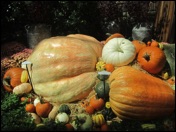
Hurry to get on our fall leaf cleanup schedule
AND for help with your fall planting projects.
We have mums, cabbage, pansies and violas.
Call Wetter Landscaping Today!!
215-661-1966
There are two obvious choices when it comes to doing your fall leaf clean-up: do it yourself or hire a professional. Wetter Landscaping provides this service and we take great pains to make sure we do it for you as efficiently as possible to keep costs down. We'll provide a free estimate based on your property and nature of the clean-up.
Many people don't realize that a fall leaf cleanup isn't necessarily a once-a-season task. It depends on the length of the fall season and the degree of neat and tidy you want on your property. Adjoining property owners may not have a similar philosophy as yours and their leaves can end up on your property adding to the job.
The good news is that do-it-yourself leaf removal doesn't have to be a blister-inducing, exhausting project. With the right tools, leaves can be gone before Sunday afternoon kick-off time.
Doing it yourself? Tips for making it easier
Come this time of year, drop your lawnmower settings down as low as it'll go without scalping the turf. Short grass gives leaves less to get caught on as they drift around the neighborhood. It also means the mower will vaporize any leaves that have already fallen.
You can also purchase a mulching mower—the kind without a bag that pulverizes clippings and drops them back into the turf to feed it. If you're going to use a leaf blower stay away from the wimpy types that can barely blow out a candle. The typical plug-in version usually isn't powerful enough to do the job efficiently. Invest a few extra bucks and get one that can handle the job properly.
Use a large tarp to move large leaf piles to either the curb for pick-up or the woods. Even better are leaf haulers which usually have sidewalls to keep the leaves corralled. They are not expensive and can save a lot of aggravation.
If you must pack your leaves into brown paper bags for municipal curb pickup, check out the Leaf Chute ($9 at Lowe's or Home Depot). It's a low-tech, three-sided plastic tube that props open the empty bag and has a wide mouth for easy loading. Once the bag is full enough to stand on its own, remove the chute and pack in as many more leaves as you can stamp down.
We all think about just letting nature take its course when it comes to fall leaf cleanup. Before choosing to just let things take care of themselves, remember that excess leaves on the lawn blocks sunlight and reduces water evaporation, which can cause fungus, mold and disease. If leaves get too thick, they can cause stress to a lawn and require re-seeding or even worse for your lawn, Wet, decomposing leaves can also be a breeding ground for mosquitoes so weigh the risks before choosing to cross a fall leaf cleanup off your list.
Cleaning up your fall leaves can be a relatively simple project when you choose to work smarter, not harder.
Winterizing your irrigation system
Without proper preparation your sprinkler system might be damaged by freezing temperatures. Here are some tips from Rain Bird on how to prepare your irrigation system for winter conditions.
1. Insulate your assets: Shut off the water supply to the irrigation system. The main shut off valve for your irrigation system needs to be protected against freezing. Make sure it is wrapped with insulation (foam insulation tape and a plastic bag) to protect it from harsh winter temperatures and prevent it from freezing. If you do not have a main shut off valve, you might consider installing one as a preventative investment. Also, any above ground piping needs to be insulated. Self-sticking foam-insulating tape or foam insulating tubes commonly found at home supply stores are fine.
2. Stay in control: If you have an automatic system then you will need to "shut down" the controller (timer). Most controllers have a "rain-mode" which simply shuts off the signals to the valves. The controller continues to keep time, the programming information isn't lost (start times, valve run times, etc.) and the clock continues to run throughout the winter. The only change is that the valves will not activate. If your controller is responsible for activating a pump, as a precaution you should remove the wires that are connected to the MV (Master Valve) and common terminals. This will prevent the possibility of the pump being accidentally activated which could cause damage from overheating. An alternative to using the rain mode is simply to shut off the power to the controller. If you do, you'll need to reprogram the time and potentially all your other settings as well, in the spring.
3. Drain the pipes: Now you need to remove the water from the pipes and sprinklers so that it won't freeze/expand and break the pipe. There are several ways to drain your pipes: a manual drain valve, an automatic drain valve or the compressed air blow-out method. However, since there could be potential safety risks we recommend contacting Wetter Landscaping as we offer sprinkler winterization services this time of year for many of our customers.
4. Protect valves and backflow preventers: Insulate backflow preventers and valves if they are above ground. You can also use insulation tape for this. Be sure not to block the air vents and drain outlets on backflow preventers.
Reprinted from RainBird



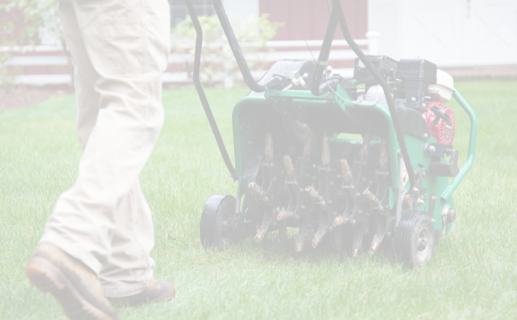
Nothing But Upsides to Fall Aeration and Seeding
Fall Clean-Up:
Why Do it?
Aerating and seeding in the fall season is one of the most important aspects of year-round maintenance for your lawn and property. Although they can be done separately, it is typically best to consider both aeration and seeding services together, as your lawn is most viable for seed growth right after aeration is completed
Aeration Benefits
Aeration is a pretty big deal in the lawn-care world, and you probably have seen the after-effects, even if you did not realize that it was called aeration. Aeration is the process through which air is circulated through, mixed with or dissolved in a liquid or a substance. The technical definition is a bit complicated, so to simplify with respect to lawn care: aeration is the process through which soil is either pounded down with spikes, or removed as core samples. In both cases the effect is the same, i.e., pockets appear where air can enter the soil more easily. Experts recommend aerating twice a year, once in spring (March-May), and once in fall (August-November). If you missed the first season, then don't stress! Just make sure to get the fall aeration done to ensure a healthy lawn throughout the winter.
The benefits of aeration compared to the time and money you may invest to accomplish the task are overwhelming. Aeration offers some of the most easily recognizable, and quickest results of any lawn maintenance operation. and below is a list of just seven of the benefits of aeration:
1. Water and Fertilizer can be used more efficiently by your lawn
2. Thatch will be minimized
3. Grass roots can grow deeper and healthier
4. Soil compaction is reduced
5. Improved lawn health
6. Improved lawn appearance
7. Ability of lawn to withstand more activity
Year-Long Beauty
Items 2 and 7 on the list, cannot be overstated enough. Thatch is a layer of dead, mostly plant tissue that protects lawns by regulating temperature. Too much thatch however, can limit soil oxygenation and watering effectiveness! Giving your lawn a good once-over with a rake can prevent some of the negative side-effects of thatch, but to truly make sure your lawn is great, aeration is necessary. Number 7 is especially important for people who like to gather outside. Anyone who has ever had a bonfire, or a party outdoors, knows that the lawn looks beaten down the next day. Aeration prevents soil from compacting under heavy strain, and also allows your grass to return more quickly to its natural state, minimizing the chance for damage.
Aeration and Grass Growth
“So what does this mean for grass growth?” You might ask. The answer is two-fold. When aeration is performed alone, the existing grass gains deeper roots, but this can lead to spotty grass due to over-competition for nutrients. To truly capitalize on your newly aerated lawn, over-seeding must be performed, and now is the perfect time to do it! Over-seeding is the process in which more grass seed than needed is laid down to increase the chance of seed germination. The whole process takes about 8-10 weeks, hence why we recommend doing it now, and almost always leads to a healthier and denser lawn. Putting down lots of grass seed also ensures that your existing grass does not grow its roots too long, which is also why we recommend performing over-seeding as soon as possible after aeration.
We hope that this summary has been helpful. If you have any questions, or would like to schedule an aeration and seeding, or any other lawn care service, call us during business hours. Wetter's team of trained professionals will ensure that your lawn is the health, happy, and beautiful.
Getting the most from your summertime plants and foliage
Visit our
Newsletter Archives
Click here to visit our Archives page where you'll find lawn and garden information you might have missed.
2110 Wentz Church Road
Lansdale, PA 19446
Email: wetterlandscaping@gmail.com • Phone: 215-661-1966
Business Hours:
Monday - Friday:
8:00 am - 5:30 pm,
Saturday: 9:00 am - 4:30 pm, Sunday: CLOSED
PA Licensed Contractor #059812
Referral Reminder
Don't forget about our Wetter Referral Program. For every new contracted customer you refer, you'll receive a free lawn cut. Just contact our office to make your referral or find out more information.
Mulch is the icing on the cake to any new landscape design, controlling weeds and offering a multitude of benefits to your garden flowers and plants. But before you put down mulch in your yard, there are some tasks that need to be completed. Below are 10 steps to prepare your landscape and flower beds for mulch.
1. Kill weeds in your landscape
Before adding mulch and embarking on your garden landscaping ideas, it's important to eliminate all unwanted plants and weed growth. Pulling up and removing unwanted plants is a simple and efficient natural weed killer. Another method for how to kill weeds is to spray them with an herbicide one to two weeks prior to mulching. This will allow the weeds to completely die. (Dead weeds are easier to pull up.)
2. Trim trees and bushes in your yard
It is best to trim nearby trees and bushes before mulching because of the debris they create.
Look Things Over and Make a Plan
By now you've probably taken a walk around your property and observed first hand any damage
and impacts from the winter season. Take stock of the situation and plan your projects for the
new season. Check out the turf for dead spots that may need seeding, address areas where
poor drainage has caused your grass to thin, and check for structural problems with any of
your ornamentals.
The first steps to launching your spring offensive is make a good hit list of the things you'll want or need to do. Mulch, weed control products, pruning and equipment are good things to consider.
Spring is in full bloom!

Pre-emergent weeding, 10 things to do before mulching and minimizing winter lawn damage
plus landscaping trends for 2018
We Deliver Mulch
$36 per yard delivered (brown dyed)
$38 per yard delivered (black dyed)
Delivery within a
10 mile radius
of our shop.
Diminish your winter lawn damage
Although we've had tons of snow, winter temperatures, wind and moisture will still take its toll on your lawn. When we look at our lawn in general, we don't see the thousands of individual grass plants. Some may be damaged and some may not. That's because there are a variety of ways a lawn can be damaged. Shade definitely hinders grass growth because the sun is needed for photosynthesis. In the winter months, shade covers different areas of your lawn than in the summer. Soil compaction damages root growth all year long, not just in winter. Poor drainage areas will also damage or even kill plants especially in winter months. Other factors including soil structure, air circulation and fungus diseases also can damage or even kill your grass plants.
Proactive solutions you or Wetter Landscaping can provide
While there is virtually no way to avoid these conditions in winter, you can mitigate some of their impacts in early spring with a couple important strategies. Wetter Landscaping offers these services or you can do them yourselves depending on how much time and effort you can invest.
• Aerate to help dry out the soil and promote fertilizer and water intake
• Thatch lightly to comb out dead grasses
• Seed and mulch to
◦ Provide new and improved grass varieties
◦ Increase the number of plants per unit of area
◦ Replace grass plants that may have died over the winter
Seed generally will not thrive where there is too much shade or where the soil has
become too compacted. To make matters more difficult, it is very hard to tell when
your soil has become compacted and that's why a professional is sometimes needed
to diagnose your lawn problems.
There are other remedies that can be employed and we would be glad to come out an do an assessement of what might be done to minimize your winter lawn damage.
Winning the war on weeds means pre-emergent weed applications
There is no debate that an early start will make the war on weeds less brutal. Our pre emergent weed applications will get you the best results and we have varying treatments for different types of lawns. Contrary to popular belief, pre-emergent weed killers don't destroy weeds and their seeds. They simply stop them from growing. Some seeds are known to last fifty years, so if the herbicide isn't applied each year, the weed will grow.
The big question for pre-emergent weed killers is when to apply them. Pre-emergent herbicides only work if they are applied to your lawn before the weed's growth period. But if applied too early, weather will dilute the herbicide and the weed will grow unencumbered. According to garden experts from many regions of the U.S., the two dates to remember are March 15 and September 15. Those are the two dates of the year around which pre-emergent fertilizers should be applied so that they activate before seasonal weeds make an appearance.
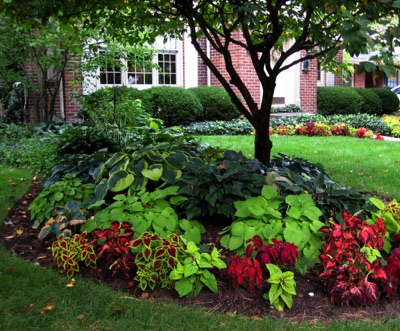
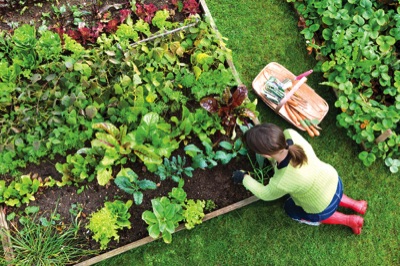
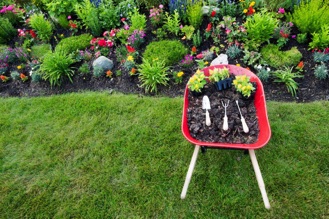
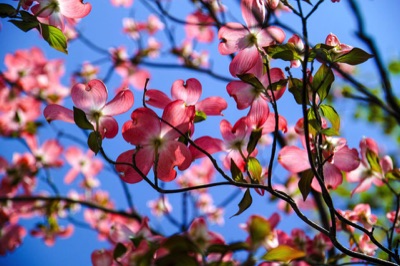
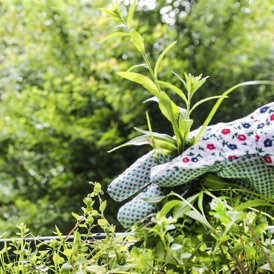
Get a Free Quote
for our "5 Step Lawn Fertilizing and Weed Control Program"
Call or email during business hours
Lawn Agreements
are now being mailed. Please mail back to our office as soon as possible.
3. Clean out your garden beds
Use a rake to remove dead leaves, weeds and trimmings. An adjustable rake is generally best for this task.
4. Cultivate your landscaping beds
After your beds have been cleaned, cultivate any compacted soil or mulch. A rototiller or hand cultivator will do the job. Cultivating will allow moisture and air to pass through the soil more easily.
5. Edge landscape beds before adding garden mulch
Creating a clean edge really enhances your landscape and gives it a professional look. An edging shovel or power edger can be used to create your edge. Try using a garden hose as a guide to create flowing curves.
6. Before you mulch your landscape, rake the area smooth
Using a stiff rake, such as a mud rake, smooth out all the surfaces to be mulched. Otherwise, your mulched flower beds or mulched areas around trees will look lumpy.
7. Apply a pre-emergent to prevent weeds
Apply a pre-emergent, such as Preen, to prevent germination of weed seeds. A second application, after the mulch has been installed, can add protection from weed seeds that may germinate into the mulch.
8. It’s time to mulch your landscape and flower beds
Using your hands or a rake, apply new mulch over the existing cultivated mulch or soil. Most experts suggest a layer of mulch 2 inches (but no more than 3) thick. When mulching around trees and woody, stemmed plants, keep the mulch away from the base. When you're finished mulching, water to moisturize mulch and help it settle into place.
9. Mulch maintenance
Once a month or so, check your mulch for compaction. If compacted, use a garden claw, rake or cultivator to loosen (scratch) it. This will allow water and air to pass, which helps prevent the growth of fungus and restores its appearance.
10. Address fungus in garden mulch right away
If fungus is present, remove it and the surrounding mulch. Rake existing mulch to cover the area, and then water thoroughly. Fungus is a sure sign that your garden mulch is compacted and your beds have dehydrated. Cultivation and watering will be necessary.

10 helpful steps to take before you mulch
Summer maintenance starts with a beautiful lawn
2110 Wentz Church Road
Lansdale, PA 19446
Email: wetterlandscaping@gmail.com • Phone: 215-661-1966
Business Hours:
Monday - Friday:
8:00 am - 5:30 pm,
Saturday: 9:00 am - 4:30 pm, Sunday: CLOSED
PA Licensed Contractor #059812
Referral Reminder
Don't forget about our Wetter Referral Program. For every new contracted customer you refer, you'll receive a free lawn cut. Just contact our office to make your referral or find out more information.
Summer maintenance starts with a beautiful lawn
We Deliver Mulch
$36 per yard delivered (brown dyed)
$38 per yard delivered (black dyed)
Delivery within a
10 mile radius
of our shop.
Get a Free Quote
for our "5 Step Lawn Fertilizing and Weed Control Program"
Call or email during business hours
If spring lawn care is about getting your lawn healthy and green, summer lawn care is about KEEPING it healthy while temperatures soar and rainfall becomes a fleeting memory. It's also about maintaining a lawn that can withstand all the barbecues, games, parties, and running feet that summer has to offer. Here are some tips for keeping your lawn in shape over those long, hot days of summer.
About Summer Lawns
Lawns need at least one inch of water per week, and more when the heat is severe. Use a rain gauge or straight-sided can to keep track of the amount of water received from rainfall and irrigation.
Many people think the summer months mean water frequently – but the way you water is more important than the frequency with which you water. Grass and plants are resilient and have mechanisms that help them deal with summer heat. For instance, grass may go dormant and look brown during times of drought, but, if it is well cared for, it may return to normal when there is adequate moisture. Efficient tips for watering include:
Water your plants less often, but deeply.
• Water in the early morning or evening hours so the sun and heat don't steal moisture from your plants. Ideally, grass should get at least one inch of water per week.
• Use drip irrigation instead of sprinklers and hoses. Drip irrigation waters plants slowly so the water doesn't run off or evaporate.
• By summer, many lawns begin to show signs of wear, especially in a few popular pathways. Consider installing stepping stones to minimize damage to your grass, and try to minimize traffic on dormant, brittle lawns.
Dormant or drought-stressed summer lawns can be more susceptible to insect infestations, such as chinch bugs, cutworms, armyworms, sod webworms, fire ants, fleas, and mosquitoes. Minor infestations often take care of themselves, but severe problems may require attention.
Summer is also the time for fungal diseases, such as powdery mildew and brown patch. Apply fungicide if needed, and avoid watering in the evening to keep nighttime moisture at a minimum.
Grubs will begin hatching in your lawn over the summer. If grubs typically cause problems in your lawn, you can begin applying grub control around midsummer.
Mowing needs some summer adjustments
• Raise your mower blade in the summer. Taller grass is more drought-tolerant, grows deeper roots, and helps shade the earth to prevent weed seeds from germinating. Cool-season grasses should be mowed at 3”- 4” during the summer, or as high as your blade will go, while warm-season grasses should be mowed at 2”- 3”.
• Mulching grass clippings helps keep moisture levels steady.
• Mow regularly, to prevent cutting more than 1/3 of the grass blade at a time. This keeps your grass healthier and prevents the clippings from smothering the grass.
If you are going through a drought and the weather is very dry, you shouldn't be cutting your grass at all. This adds unnecessary stress to the grass during a time when it's already scarcely growing. If you walk on your grass and can still see your footprints an hour or two later, it is probably too dry to mow.
Trimming is winning when it comes to avoiding trouble
Check your trees for dead hanging limbs that you might need to cut away. Thunderstorms are frequent during the summer and tree limbs can do a great deal of damage. Also, prune any plants that might interfere with your AC condenser and trim bushes that might be too close to the house.
Trim any bushes. If left untrimmed, they can trap moisture and they invite termites. Keeping bushes trimmed can also eliminate potential hiding places for burglars or other unwanted visitors.
Vines come from the ground and grow on the house. Creepy crawlies come from the ground, too, and they can use those vines to get into your house. Vines also trap moisture against the house and they can eat away the mortar in between your bricks, jeopardizing the stability of your exterior walls.
So, while vines might be pretty they are not good for your house and you should trim them back regularly. If you really want to keep the vines hanging around, here's a tip — install a garden trellis next to your house. They come in a variety of sizes and they keep vines away from your foundation.
Don't forget the potted plants
Many people add potted flowers and herbs to their outdoor living spaces in the summer months. If doing so, protect your investment and enjoy them fully by watering potted plants regularly, add mulch to pots to help retain moisture and place them in spots where they will get shade during the day.

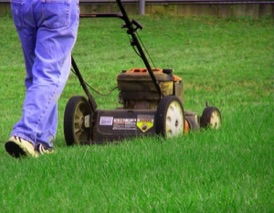
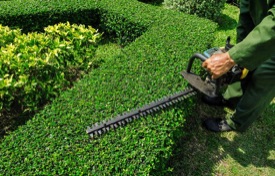
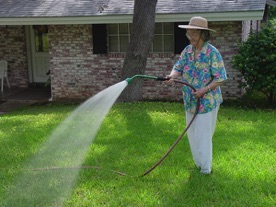
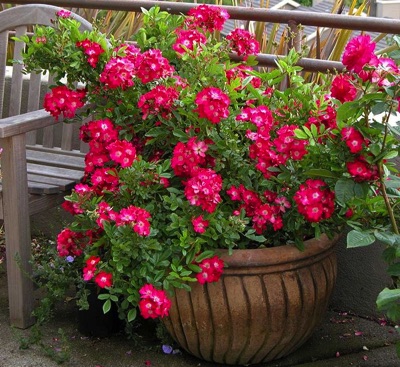

BEWARE OF THE SPOTTED LANTERNFLY!
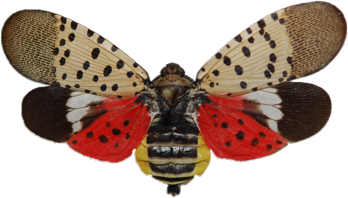
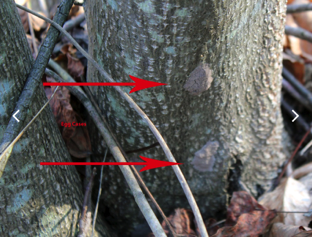
If you think you might be affected, call us immediately to discuss our remedial program and inspection procedures.
The commonwealth of Pennsylvania has an insect problem that's reaching crisis levels. Its name is the spotted lanternfly and if you're seeing strange damage to your trees,
you might be at risk. In February 2018, the USDA officially declared war on the spotted lanternfly, giving Pennsylvania $17.5 million to fight the invasive species.The spotted lanternfly is about an inch long, boasting peacock-like spotted outer wings and jarringly bright, red and black inner wings. Despite those showy appendages, it’s not good at flying and instead prefers to hop. Native to Vietnam, China, and India, it has become a major invasive species in the two places it has managed to travel to: South Korea and Pennsylvania.
egg sacs

Visit our
Newsletter Archives
Click here to visit our Archives page where you'll find lawn and garden information you might have missed.












